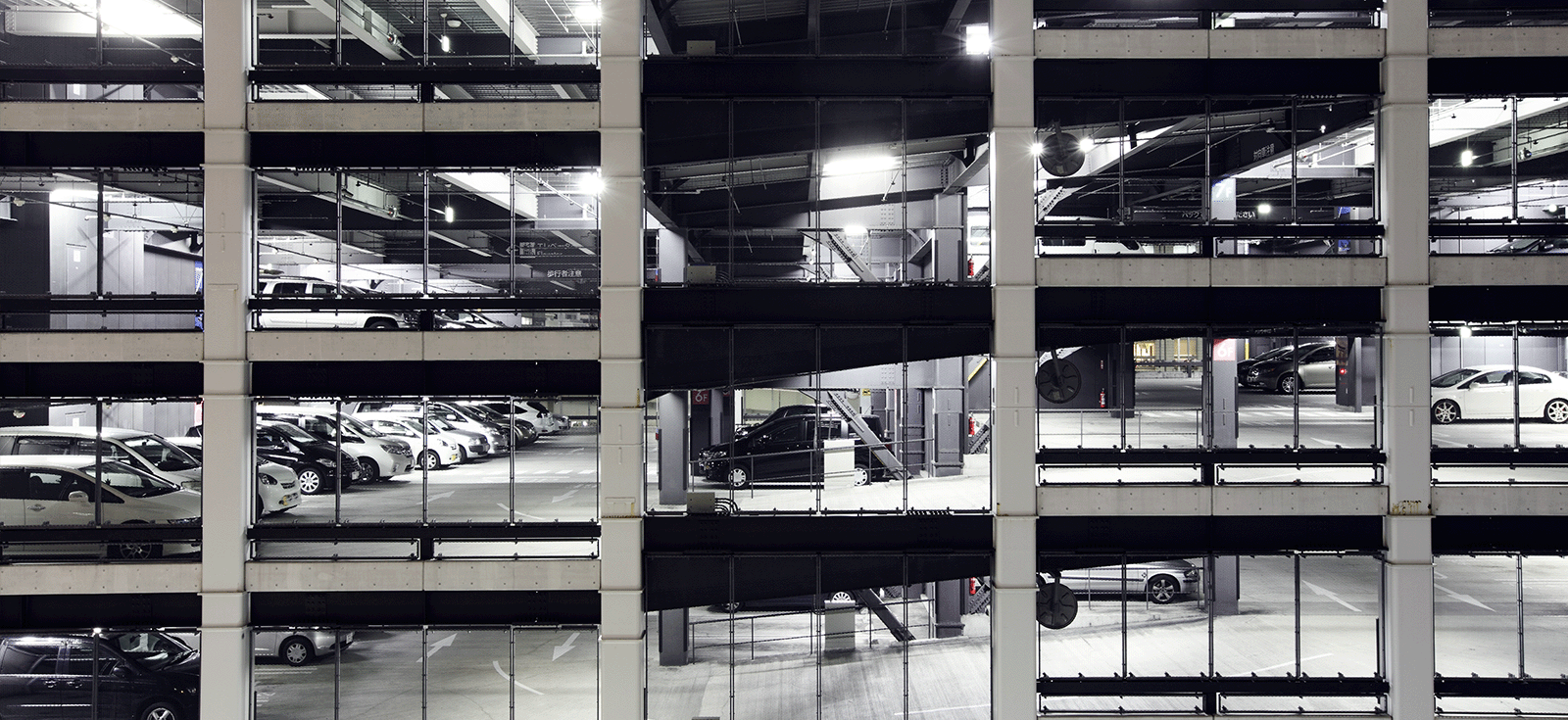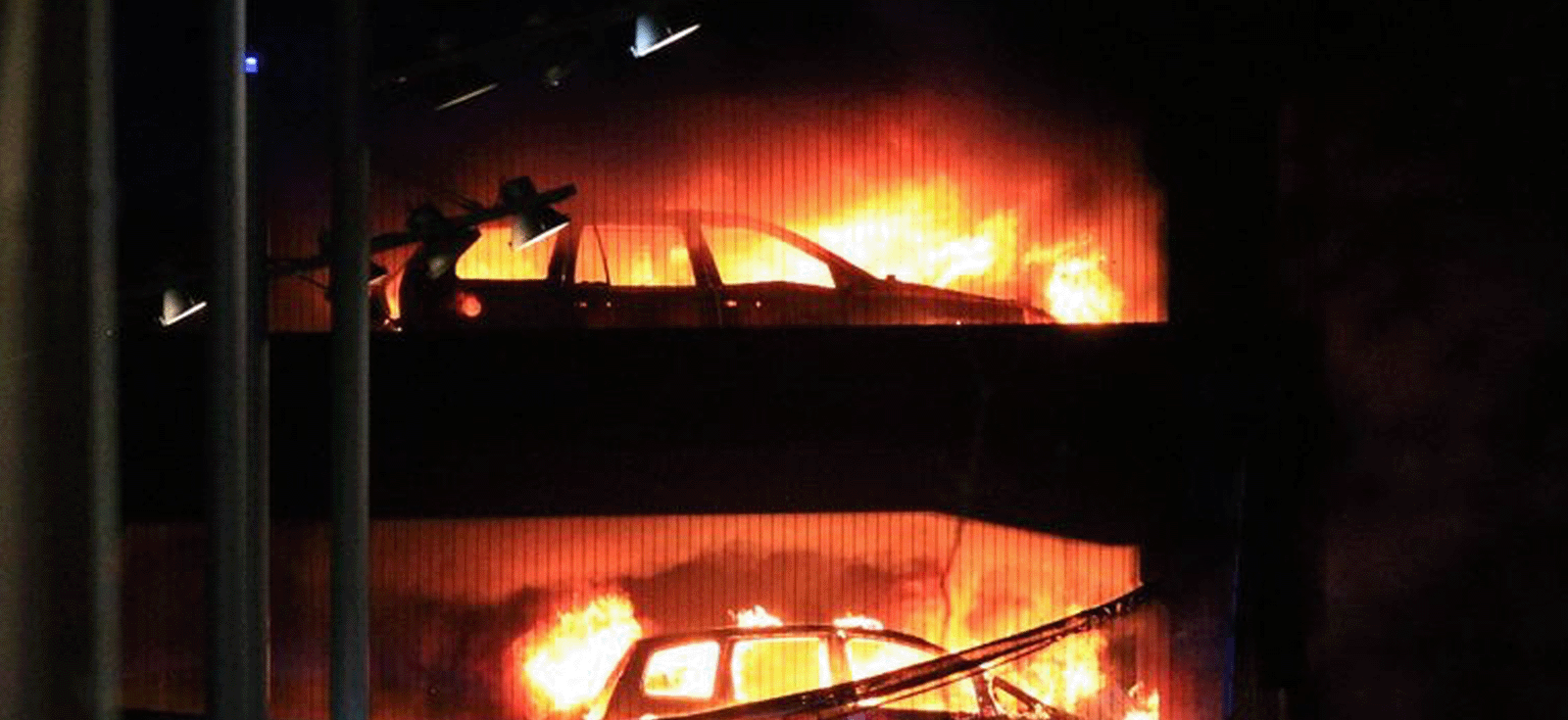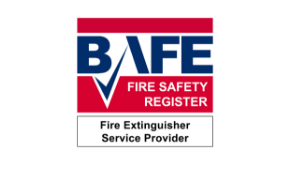In today’s urban landscapes, multi-storey car parks are essential. They maximise limited space, offering convenient parking solutions in bustling cities. However, these structures pose unique fire risks, which are further exacerbated by the increasing prevalence of electric vehicles (EVs). According to the BBC, “in 2022-23, fire services across England recorded more than 19,000 vehicle fires”. Understanding these risks and implementing effective fire protection strategies is crucial for safety and resilience.
The Unique Dangers of Multi-Storey Car Park Fires
Structural Concerns
Multi-storey car parks are designed to accommodate numerous vehicles within a confined space. This design creates several challenges. High temperatures from vehicle fires can significantly compromise the structural integrity of concrete and steel used in the construction of these car parks. Prolonged exposure to heat can weaken these materials, potentially leading to partial or total structural collapses.
Additionally, the inherent design of these car parks often includes limited ventilation. Poor ventilation can cause rapid smoke accumulation during a fire, reducing visibility and increasing the risk of asphyxiation for occupants and firefighters. Effective smoke control systems are essential to mitigate these risks and ensure safe evacuation and firefighting efforts.
Fire Spread
Vehicle fires can spread quickly due to the nature of the materials involved. Cars contain a variety of flammable materials, including fuel, upholstery and tires. Once ignited, these materials can cause the fire to spread rapidly to adjacent vehicles, particularly when cars are parked in close proximity to one another.
This rapid fire spread can create a domino effect, where multiple vehicles catch fire in quick succession. The close spacing of vehicles in multi-storey car parks exacerbates this issue, making it critical to have effective fire suppression systems in place to quickly contain and extinguish fires before they can spread uncontrollably.
Evacuation and Access
Evacuation and access during a fire in a multi-storey car park present significant challenges. The complex layouts of these car parks can make it difficult for occupants to quickly find exits, particularly in low-visibility conditions caused by smoke. Well-marked evacuation routes and emergency lighting are crucial to guide occupants to safety.
Moreover, the narrow ramps and entrances that characterise many multi-storey car parks can hinder the movement of firefighting equipment and personnel. Ensuring that these access points are kept clear and designing car parks with firefighting access in mind can significantly improve emergency response times and effectiveness.

Electric Vehicle Fires
Electric vehicles (EVs) introduce additional fire risks due to their lithium-ion batteries. These batteries are prone to thermal runaway, a condition where the battery cells overheat and enter a self-sustaining reaction, leading to high temperatures and difficult-to-extinguish fires. On average, it takes fire and rescue services around 30 minutes to extinguish a petrol or diesel car fire, however, when with an EV fire it takes 4 to 5 hours. EV fires also release toxic fumes, including hydrogen fluoride, posing significant health risks to occupants and emergency responders. Furthermore, damaged batteries can reignite hours or even days after the initial fire, necessitating continuous monitoring and cooling.
In the UK, the growing adoption of EVs has raised concerns about fire safety. According to the RAC, as of this year there is an estimated 1.1 million battery electric vehicles throughout the UK, a significant increase from previous years. While comprehensive statistics on EV fires are still emerging, data from the London Fire Brigade indicates that they attended 115 electric vehicle fires between 2021 and 2023. This number is expected to rise as the adoption of EVs continues to accelerate. The need for specialised firefighting techniques and equipment to handle these unique risks underscores the importance of updated fire safety protocols in multi-storey car parks and other areas where EVs are commonly found.
The Fire Triangle
Fire safety revolves around understanding the fire triangle, which consists of three elements: Heat, Fuel and Oxygen. A fire needs all three elements to ignite and sustain itself. In the context of multi-storey car parks, these elements are readily available:
- Heat: Vehicle engines, exhaust systems, and electrical components can be sources of ignition.
- Fuel: Cars contain flammable materials like fuel, upholstery, and tires.
- Oxygen: Ample air supply in open car park structures facilitates combustion.
To stop a fire, at least one of these elements must be removed, effectively interrupting the fire triangle:
- Reducing Heat: This can be achieved through various cooling methods. Water-based suppression systems, such as sprinklers and water mist systems, are highly effective at absorbing heat. These systems spray water or mist over the fire, lowering the temperature and preventing the fire from spreading.
- Removing Fuel: Fuel removal involves eliminating the materials that sustain the fire. In multi-storey car parks, this can be challenging due to the presence of numerous vehicles containing flammable materials.
- Limiting Oxygen: Oxygen deprivation is another effective method for extinguishing fires. This can be accomplished by using fire suppression systems that create a barrier between the fire and the air. For instance, foam suppression systems work by covering the burning area with a thick layer of foam, cutting off the oxygen supply and smothering the fire.
By understanding and implementing strategies to interrupt the fire triangle, multi-storey car parks can significantly enhance their fire safety measures. Effective cooling, fuel management, and oxygen control are key components of a comprehensive fire protection plan that addresses the unique risks of these environments.

The Impact of Electric Vehicles on Fire Safety
Battery Fires
Electric vehicles (EVs) introduce additional risks due to their lithium-ion batteries. One of the most significant risks is thermal runaway, a condition where the battery cells overheat and enter a self-sustaining reaction. This can lead to extremely high temperatures and difficult-to-extinguish fires. The intense heat generated by a battery fire can quickly spread to other parts of the vehicle and adjacent vehicles.
Additionally, burning batteries release toxic fumes, including hydrogen fluoride, which pose significant health risks to both occupants and emergency responders. These toxic gases can cause severe respiratory issues and other health problems if inhaled, highlighting the need for effective ventilation and protective equipment during firefighting operations.
Re-ignition
One of the unique challenges of EV fires is the potential for re-ignition. Even after a fire appears to be extinguished, damaged batteries can reignite hours or even days later. This poses ongoing risks and requires continuous monitoring and cooling of the affected batteries to prevent further incidents. Firefighting teams must be trained to handle these situations and have the necessary equipment to safely monitor and manage potentially unstable batteries.
High Voltage Risks
Electric vehicles operate using high-voltage systems, which pose additional risks during a fire. Damaged high-voltage components can create electrical hazards, increasing the risk of electrocution for emergency responders. Firefighters must be aware of these dangers and take appropriate precautions when dealing with EV fires.
To mitigate these risks, it is important to develop protocols for safely deactivating high-voltage systems in EVs and to provide firefighters with the necessary training to recognise and manage these hazards. Ensuring the safety of emergency personnel is paramount in any fire scenario, particularly when dealing with the unique risks associated with electric vehicles.
The Liverpool King’s Dock Car Park Fire: A Case Study
The fire at Liverpool’s King’s Dock car park in December 2017 serves as a stark reminder of the potential devastation caused by car park fires. The blaze, which destroyed around 1,400 vehicles, highlighted several critical issues related to fire safety in multi-storey car parks.
On New Year’s Eve, a vehicle fire rapidly spread through the seven-storey King’s Dock car park. The intense heat and flames caused the complete collapse of the building, resulting in significant financial losses and logistical challenges. The fire’s rapid spread was exacerbated by the close proximity of vehicles and the flammable materials within them.
One of the key takeaways from this incident was the importance of effective fire suppression systems. According to a report by the Fire Industry Association (FIA), if sprinklers had been installed in the car park, the fire could have been contained much earlier, potentially preventing the extensive damage. Sprinkler systems can play a crucial role in suppressing vehicle fires and preventing them from spreading to adjacent cars and structural elements.
The King’s Dock fire also underscored the need for robust evacuation and access plans. The complex layout of the car park, combined with the rapid spread of smoke, made it challenging for emergency responders to access the site and contain the blaze. Improved signage, better emergency lighting, and clear access routes for firefighting equipment could have mitigated some of these challenges.

Comprehensive Solutions for Multi-Storey Car Park Fire Safety
CDS: Advanced Solutions for Fire Safety
At CDS, we offer a range of solutions to mitigate the risks associated with multi-storey car park fires:
- Fire Detection and Alarm Systems: Our state-of-the-art fire detection and alarm systems provide early warning, facilitating prompt evacuation and response. These systems are designed to quickly identify the presence of smoke or fire, alerting occupants and emergency services to take immediate action.
- Smoke Control and Ventilation Systems: we offer advanced smoke control and ventilation systems. These systems are essential for maintaining air quality and visibility during a fire, reducing the risks posed by smoke inhalation and aiding in the safe evacuation of occupants. Effective ventilation systems can also help to control the spread of smoke and heat, improving the overall safety of the car park.
- Automatic Sprinkler Systems: These systems are reliable and widely used solution for fire suppression. Automatic sprinkler systems activate promptly in the event of a fire, delivering water to the affected area to suppress the flames. They are an essential component of any comprehensive fire protection strategy, providing immediate response to contain and extinguish fires before they can spread.
Bryland Fire: Expertise in Fire Suppression
Our sister company, Bryland Fire, specialises in fire suppression systems that are crucial in controlling and extinguishing fires in multi-storey car parks:
- Water Mist Systems: Highly effective in cooling flames and reducing heat transfer, minimising structural damage and preventing the spread of fire. Water mist systems use fine water droplets to suppress fires, creating a cooling effect that helps to control the blaze.
- Foam Suppression Systems: Ideal for tackling flammable liquid fires, such as those involving vehicle fuel. These systems create a blanket of foam that smothers the fire, cutting off the supply of oxygen and preventing re-ignition. Foam suppression systems are particularly useful in environments where flammable liquids are present, providing an additional layer of protection.
Drax Technology: Cutting-Edge Fire Alarm Monitoring
Drax Technology, another sister company, provides advanced fire alarm monitoring solutions to ensure continuous surveillance and rapid response:
- Real-Time Monitoring: AMX allows for immediate action in the event of a fire. This continuous monitoring ensures that any fire incidents are quickly identified and addressed, minimising the risk of widespread damage.
- Integrated Solutions: Seamlessly integrate fire alarm monitoring with existing fire safety infrastructure. We provide comprehensive protection for multi-storey car parks as integrated systems ensure that all aspects of fire safety work together effectively, enhancing the overall safety and resilience of the building.
- Remote Access: AMX Connect enables the monitoring and management of fire safety systems from any location. This remote access ensures that fire safety systems can be quickly assessed and managed, even when on-site personnel are not available. By providing real-time data and alerts, remote access systems enhance the ability to respond to fire incidents promptly and effectively.
As multi-storey car parks continue to accommodate an increasing number of electric vehicles, understanding and addressing the unique fire risks they pose is essential. With comprehensive solutions from CDS, Bryland Fire, and Drax Technology, we can significantly enhance the safety and resilience of these structures. By leveraging advanced detection, suppression, and monitoring technologies, we can effectively mitigate the risks and ensure the safety of both occupants and emergency responders.
The Liverpool King’s Dock car park fire serves as a poignant example of the potential devastation caused by car park fires and underscores the importance of effective fire safety measures. Contact us today for more information on our fire safety solutions and how we can help protect your multi-storey car parks.


















